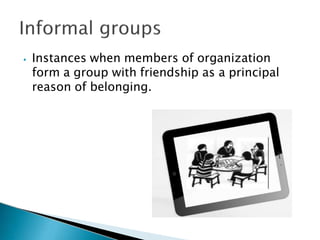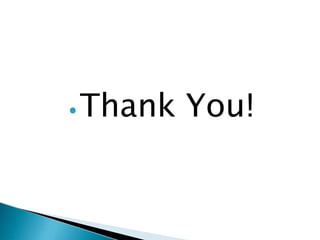chapter-4-organizing-technical-activities.pptx
- 2. ⦁ Organizing is undertaken to facilitate the implementation of plans. In effective organizing, steps are undertaken to breakdown the total job into more manageable man-size jobs.
- 3. ⦁ Organizing is a management function which refers to "the structuring of resources and effective manner". ⦁ The result of organizing process is the structure.
- 4. 1. It defines the relationships between tasks and the authority for individuals and departments 2. It defines formal reporting relationships, the number of levels in the hierarchy of the organization, and the span of control. 3. It defines the groupings of individuals into departments into organization. 4. It defines the system to effect coordination of effort in both vertical (authority) and horizontal (tasks) directions.
- 5. 1. Division of labor 2. Delegation of authority Departmentation 3. Span of Control 4. Coordination
- 6. ⦁ It is the structure that details lines of responsibilities, authority, and position
- 7. 1. Organization chart. 2. Organization manual 3. Policy Manuals
- 8. ⦁ It is the diagram of the organization's official positions and formal lines of authority.
- 9. ⦁ It provides written description of authority relationships, details the functions of major organizational units, and describes job procudures.
- 10. ⦁ it describes personnel activities and company policies.
- 11. ⦁ Instances when members of organization form a group with friendship as a principal reason of belonging.
- 12. ⦁ A leader in a formal, hierarchical organization, who is appointed to a managerial position, has the right to command and enforce obedience by virtue of the authority of his position.
- 14. ⦁ 1. Functional Organization - This is a from of departmentalization in which everyone engaged in one functional activity, such as engineering or marketing, is grouped in one unit.
- 15. 1. The grouping of employees who perform task permit economies of scale and efficient resource use. 2. Since the chain of command converges at the top of the organization, decision making is centralized provided unified direction from the top. 3. Communication and coordination among employees within each department are excellent.
- 16. ⦁ 4. The structure promotes high-quality technical problem solving. ⦁ 5. The organization is provided with in depth skill specialization and development. ⦁ 6. Employees are provided with career progress within functional departments.
- 17. ⦁ 1. Communication and coordination between departments are often poor. ⦁ 2. Decisions involving more than one department pile up at the top management level are often delayed. ⦁ 3. Work specialization and division of labor, which are stressed in a functional organization, produce routine, non- motivating employee tasks.
- 18. ⦁ 4. it is difficult to identify which section or group is responsible fro certain problems. ⦁ 5. There is limited vies of organizational goals by employees. ⦁ 6. There is limited general management training for employees.
- 19. ⦁ 2. Product or Market Organization - This refers to the organization of a company by divisions that brings together all those involved with a certain type of product or customer
- 20. ⦁ 1. The organization is flexible and responsive to change. 🞂 2. The organization provides a high concern for customer's needs. ⦁ 3. The organization provides excellent coordination across functional departments.
- 21. ⦁ 4. There is easy pinpointing of responsibility for product problems. ⦁ 5. There is emphasis on overall product division goals. ⦁ 6. The opportunity for the development of general management skills is provided.
- 22. ⦁ 1. There is high possibility of duplication of resources across divisions. ⦁ 2. There is less technical depth and specialization in divisions. ⦁ 3. There is poor coordination across divisions. ⦁ 4. There is less top management control. ⦁ 5. There is competition for corporate resources.
- 23. ⦁ 3. Matrix Organization - It is an organizational structure in which each employee reports to both a functional or division manager and to a project or group manager.
- 24. 1. There is more efficient use of resources than the divisional structure. 2. There is flexibility and adaptability to changing environment. 3. The development of both general and functional management skills are present. 4. There is interdisciplinary cooperation and any expertise is available to all divisions. 5. There are enlarged task for employees which motivate them together.
- 25. 1. There is frustration and confusion from dual chain of command. 2. There is high conflict between divisional and functional interests. 3. There are many meetings and more discussion than action. 4. There is a need for human relations training for key employees and managers. 5. There is a tendency for power dominance by one side of the matrix.
- 26. 1. Line Authority. A manager to tell subordinates what to do and then see that they do it. 2. Staff Authority. A staff specialist's right to give advice to a superior. 3. Functional Authority. A specialist's right to oversee lower level personnel involved in that specialty, regardless of where the personnel are in the organization.
- 28. ⦁Thank You!



























